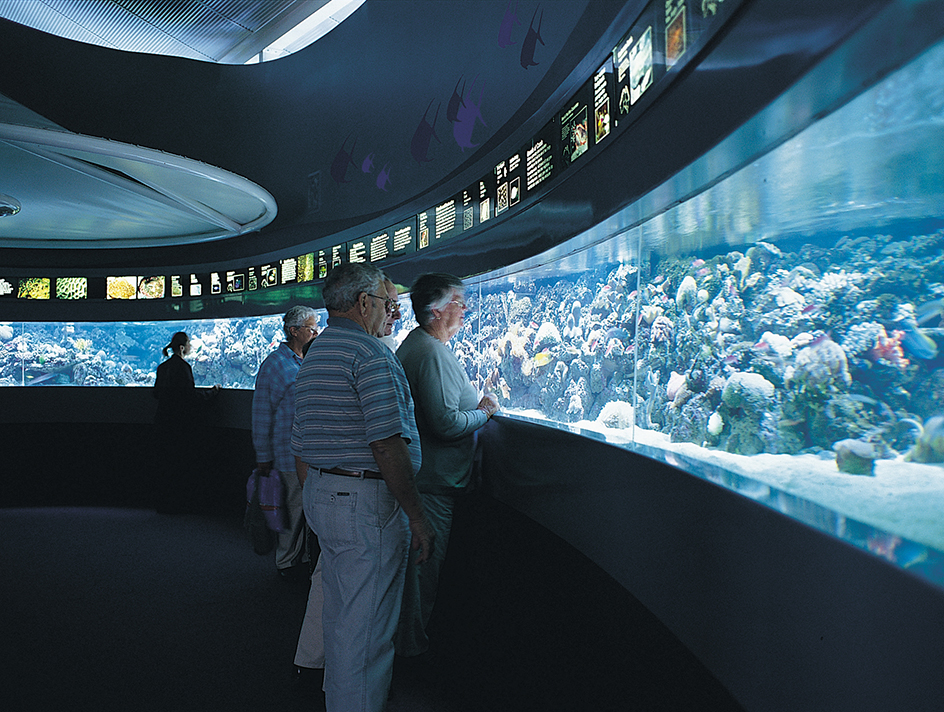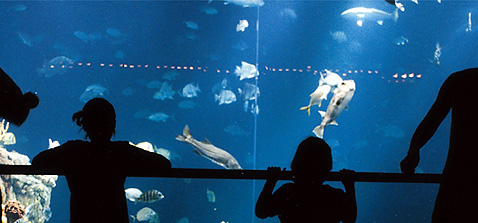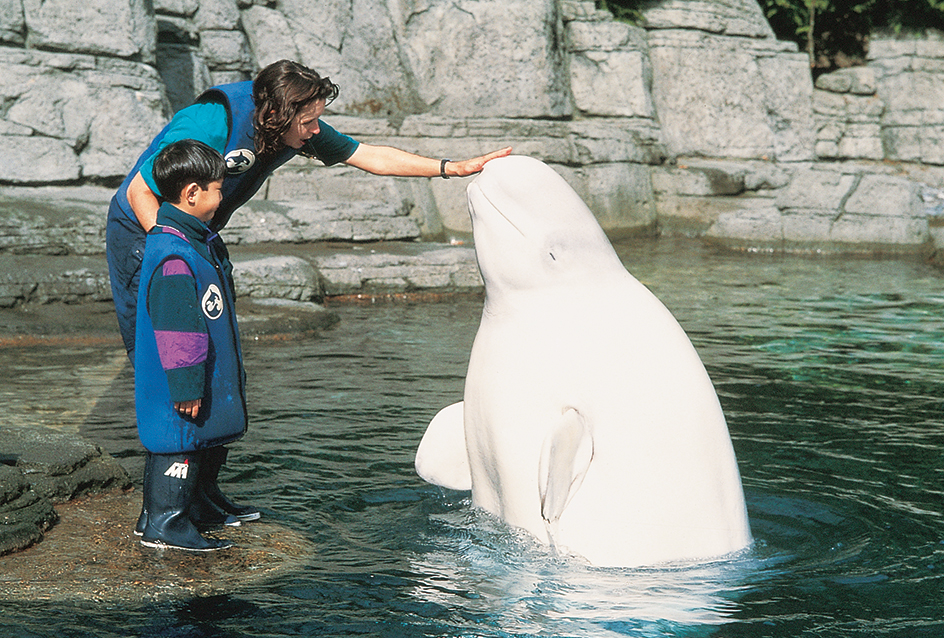Aquarium, Public, is an institution where people keep and display fish and other animals that live in water. Aquariums are also called aquatic zoos. Most public aquariums are independent institutions. Some aquariums are parts of zoos. Aquariums called oceanariums primarily display large marine (saltwater) mammals. Their animals often include dolphins, seals, and whales. Other aquariums combine a traditional aquarium with an oceanarium. Such institutions may have large indoor and outdoor exhibits.
The word aquarium also refers to small collections of aquatic life that people keep in their homes. For information on these aquariums, see Aquarium, Home.

The purpose of aquariums
Public aquariums serve many purposes. These purposes include recreation, education, research, and conservation.
Recreation.
People enjoy seeing live aquatic animals. The animals’ interesting behavior and unusual appearance attract visitors to aquariums. Aquariums use huge tanks with acrylic (plastic) viewing windows. These exhibits let visitors observe many underwater creatures they might otherwise never see. Aquariums may also present popular shows featuring seals, dolphins, and other trained marine mammals.

Education.
Aquarium visitors learn many interesting facts about aquatic life. The exhibits usually display information about the animals. Students take school field trips to aquariums to learn more about the animals they study in class. Most aquariums provide tours and lectures for schoolchildren and other groups.

Research.
Creating the appropriate environment for each aquarium animal requires extensive research on that animal’s habitat and way of life. Much of our knowledge of the lives of aquatic animals comes from such research. For example, biologists have learned most of what they know about the pregnancy of certain whale species by studying the animals in aquariums. Aquariums also have advanced the practice of aquaculture by studying the diets and diseases of food fish and shellfish. Aquaculture is the raising of aquatic life for food and other uses.
Conservation.
Aquariums help conserve threatened aquatic animals. For example, they may raise populations of threatened species whose natural habitats have been damaged. Such animals include a species of steelhead from central California. Water levels in the Carmel River, the steelhead’s habitat, sometimes become low because people use the river as a water source. To protect this fish from extinction, the Monterey Bay Aquarium collects the fish’s eggs from the river. The aquarium then raises the fish to maturity. When the river’s water level is high enough, aquarium workers release the captive-raised steelheads back into their natural habitat. Such activities keep river populations of the fish high enough to ensure their survival.
Aquariums also help raise visitor awareness of conservation issues. For example, whale and dolphin shows inform visitors about the declining numbers of marine mammals. Increased awareness has led to legislation protecting marine mammals and their habitats.
How aquariums operate
Obtaining animals.
Aquariums often rely on their own breeding programs to provide many of their exhibit animals. To expand the range of their collections, however, aquariums must purchase animals from outside sources. Public aquariums buy many of their animals from the suppliers that sell aquatic life to fish markets and pet shops. Aquariums also exchange animals among one another. On occasion, aquariums acquire specimens from individual fish collectors. They may also collect species directly from nature. Public aquariums must obtain permits to acquire and display threatened species. They also need permits to display species considered harmful to local water habitats.
Displaying exhibits.
Aquarium exhibits come in many sizes. They range from small 10-gallon (38-liter) glass tanks to huge habitat exhibits. Large exhibits might hold more than 2 million gallons (7.6 million liters) of water. Public aquariums display different animals for different reasons. Some creatures, such as blind cavefish, have specialized adaptations for unusual habitats. Others, including lobsters and groupers, provide people with important sources of food.
Aquarium exhibits place together animals that live together in nature. Most exhibits attempt to re-create particular environments. These environments include coral reefs, rocky shores, and tide pools. Aquarium workers add rocks, plants, and other features of an environment to each exhibit. These additions help satisfy the animals’ needs. They also make the exhibits more realistic for viewers.
Most large public aquariums display habitats from around the world. Smaller, regional ones often emphasize local environments. Many aquariums use one or more tanks to present short-run exhibits, which last 12 to 18 months. These presentations might focus on one region, such as Mexico’s Gulf of California. Or they might present a group of animals, such as sharks or sea horses.
A number of aquariums have created presentations called immersion experiences. These presentations give visitors an unusual perspective of aquatic environments. For example, certain aquariums take guests through shark-inhabited tanks on moving sidewalks in acrylic tunnels.
Caring for the animals
involves many tasks. They include feeding, maintaining life support systems, , and providing medical care.
Feeding.
Aquarium animals require a variety of specialized diets. Most aquarium inhabitants will eat a wide range of frozen natural foods, such as fish, shrimp, and squid. But many species will consume only live animals. Aquariums raise and maintain a number of live foods, including algae, crabs, and small bait fish.
Life support systems.
An aquarium’s exhibit tank must always have clean water processed through life support systems. These systems maintain a safe environment for the animals. They circulate the water and maintain high levels of dissolved oxygen for animals to breathe. Filters remove particles of dirt and animal waste. Water treatments eliminate dissolved poisonous materials. Life support systems also keep the water at an appropriate and stable temperature.
Medical care.
Nearly all aquariums employ a veterinarian to help care for their animals. When a new animal arrives, the aquarium at first keeps it quarantined. During quarantine, aquarium workers clean the animal of parasites and check for diseases. Daily observations of the animals help identify medical problems that may require treatment.
Jobs.
Many aquarium jobs require a college degree, experience working with animals, or both. These aquarium professions include those of veterinarians, biologists, and laboratory technicians. Workers called aquarists take care of exhibits. Trainers work with animals in shows. Other aquarium employees help educate tour groups and maintain the life support systems.
History
Archaeological records indicate that the ancient Sumerians, in what is now Iraq, kept food fish in ponds over 4,500 years ago. About 2,000 years ago, ancient Romans kept both food fish and pet fish in shallow ponds and pools. The Chinese probably bred the first domestic goldfish more than 1,000 years ago. They displayed these fish in porcelain vessels.
During the mid-1800’s, the invention of relatively clear glass tanks led to the development of modern aquariums. In 1853, the Zoological Society of London opened the first true public aquarium. This aquarium, called the “Fish House,” was part of the zoological gardens in London. The exhibition became popular. Other aquariums opened in cities across Europe over the next 20 years. The first true public aquarium in North America, the Boston Aquarial Gardens, opened in 1859.
Marine Studios was founded near St. Augustine in 1938 for filming underwater motion-picture scenes. The park, later called Marineland Dolphin Adventure, soon became a popular tourist attraction. It developed trained animal shows with dolphins and other sea mammals. Marineland’s success led to the foundation of similar theme parks, including the popular SeaWorld parks. Such places, in turn, helped promote the development of oceanariums.
During the late 1900’s, aquariums became both more numerous and more controversial. The invention of large acrylic viewing panels in the 1970’s enabled aquariums to showcase large aquatic habitats. Improved technology increased the popularity of aquariums. Some animal welfare groups, however, raised concerns about oceanariums. Such groups oppose keeping large sea mammals in captivity. They argue that aquarium environments are too restrictive for these creatures. The animals’ natural habitats often cover large areas of the oceans. Despite such criticism, an unprecedented number of oceanariums and other aquariums were built worldwide in the late 1900’s and early 2000’s.
See also Zoo.
